form组件
form验证
以前我们写form表单验证是这样的:
views.py

1 def login(request): 2 # f = open("templates/login.html","r",encoding="utf-8") 3 # date = f.read() 4 # f.close() 5 6 error_msg = " " 7 if request.method == "POST": 8 user = request.POST.get("user",None) 9 pwd = request.POST.get("pwd",None) 10 11 if user=="root" and pwd=="123": 12 return redirect("http://www.baidu.com") 13 else: 14 error_msg = "用户名密码错误" 15 16 return render(request,"login.html",{"error_msg":error_msg})
login.html

1 <!DOCTYPE html> 2 <html lang="en"> 3 <head> 4 <meta charset="UTF-8"> 5 <title>Title</title> 6 <link rel="stylesheet" href="/static/commons.css" /> 7 <style> 8 label{ 9 width: 80px; 10 text-align: right; 11 display: inline-block; 12 } 13 </style> 14 </head> 15 <body> 16 <form action="/login/" method="post"> 17 <p> 18 <label for="username">用户名:</label> 19 <input id="username" name="user" type="text" /> 20 </p> 21 <p> 22 <label for="password">密码:</label> 23 <input id="password" name="pwd" type="text" /> 24 <input type="submit" value="提交" /> 25 <span style="color: red">{{ error_msg }}</span> 26 </p> 27 </form> 28 <script src="/static/jquery-1.12.4.js"></script> 29 </body> 30 </html>
这样是可以的,但是不能细化每行的错误提示,其实在django中django自带了form的验证
是这样的
views.py
1 from django import forms 2 class FM(forms.Form): 3 user = forms.CharField(error_messages={"required":"用户名不能为空"}) 4 pwd = forms.CharField( 5 max_length=12, 6 min_length=6, 7 error_messages={"required":"密码不能为空","max_length":"密码长度不能超过12","min_length":"密码长度不能小于6"} 8 ) 9 email = forms.EmailField(error_messages={"required":"邮箱不能为空","invalid":"邮箱格式不正确"}) 10 11 def fm(request): 12 if request.method == "GET": 13 return render(request,"fm.html") 14 elif request.method == "POST": 15 obj = FM(request.POST) 16 r1 = obj.is_valid() 17 # print(r1) 18 if r1: 19 print(obj.cleaned_data) 20 else: 21 print(obj.errors) 22 return render(request, "fm.html",{"obj":obj})
fm.html
1 <!DOCTYPE html> 2 <html lang="en"> 3 <head> 4 <meta charset="UTF-8"> 5 <title>Title</title> 6 </head> 7 <body> 8 <form action="/fm/" method="post"> 9 {% csrf_token %} 10 <p><input type="text" name="user" />{{ obj.errors.user.0 }}</p> 11 <p><input type="text" name="pwd" />{{ obj.errors.pwd.0 }}</p> 12 <p><input type="text" name="email" />{{ obj.errors.email.0 }}</p> 13 <p><input type="submit" value="提交" /></p> 14 15 </form> 16 </body> 17 </html>
显示效果:
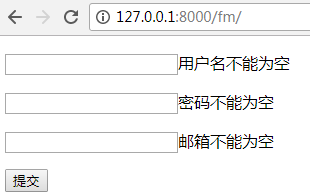
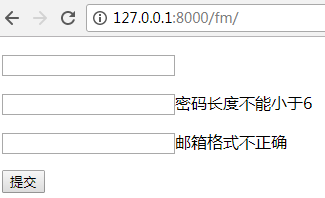
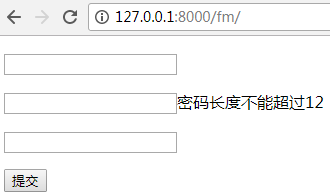
但是还存在一个问题,你看,一点提交,数据都跑哪里了, 填写的数据不见了,怎么办呢?那要是我们想保留上一次操作的数据?
可以这样搞一下,
django中的form还可以生成<input>标签的
views.py
1 def fm(request): 2 if request.method == "GET": 3 obj = FM() 4 return render(request,"fm.html",{"obj":obj})
fm.html
1 <!DOCTYPE html> 2 <html lang="en"> 3 <head> 4 <meta charset="UTF-8"> 5 <title>Title</title> 6 </head> 7 <body> 8 <form action="/fm/" method="post"> 9 {% csrf_token %} 10 <p>{{ obj.user }}{{ obj.errors.user.0 }}</p> 11 <p>{{ obj.pwd }}{{ obj.errors.pwd.0 }}</p> 12 <p>{{ obj.email }}{{ obj.errors.email.0 }}</p> 13 <p><input type="submit" value="提交" /></p> 14 15 </form> 16 </body> 17 </html>
显示效果:
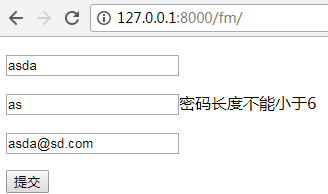
那如果提交是正确的数据呢?返回到后端显示的是一个字典格式的
那么这样写就可以在数据库中添加一个用户,完成注册了
1 from app01 import models 2 def fm(request): 3 if request.method == "GET": 4 obj = FM() 5 return render(request,"fm.html",{"obj":obj}) 6 elif request.method == "POST": 7 obj = FM(request.POST) 8 r1 = obj.is_valid() 9 # print(r1) 10 if r1: 11 #print(obj.cleaned_data) 12 models.UserInfo.objects.create(**obj.cleaned_data) #完成注册添加进数据库
在html中还 可以在简化,看下面
1 <!DOCTYPE html> 2 <html lang="en"> 3 <head> 4 <meta charset="UTF-8"> 5 <title>Title</title> 6 </head> 7 <body> 8 <form action="/fm/" method="post"> 9 {% csrf_token %} 10 {# <p>{{ obj.user }}{{ obj.errors.user.0 }}</p>#} 11 {# <p>{{ obj.pwd }}{{ obj.errors.pwd.0 }}</p>#} 12 {# <p>{{ obj.email }}{{ obj.errors.email.0 }}</p>#} 13 {{ obj.as_p }} 14 15 {{ obj.as_ul }} 16 17 <table>{{ obj.as_table }}</table> 18 19 <p><input type="submit" value="提交" /></p> 20 21 </form> 22 </body> 23 </html>
显示效果:
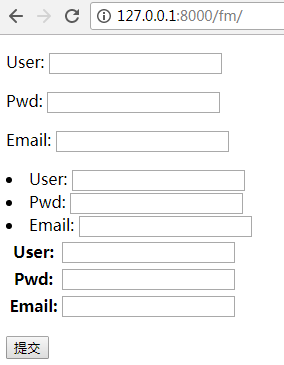 但是不建议这样做,这样做不能针对每一个自定制的标签做处理。
但是不建议这样做,这样做不能针对每一个自定制的标签做处理。
form字段,用于对用户请求数据的验证
1 from django import forms 2 from django.forms import fields #字段 3 from django.forms import widgets #插件 4 class FM(forms.Form): 5 user = fields.CharField( 6 error_messages={"required":"用户名不能为空"}, 7 widget=widgets.CheckboxInput(attrs={"class":"c1",}) 8 )
django的内置字段

1 Field 2 required=True, 是否允许为空 3 widget=None, HTML插件 4 label=None, 用于生成Label标签或显示内容 5 initial=None, 初始值 6 help_text='', 帮助信息(在标签旁边显示) 7 error_messages=None, 错误信息 {'required': '不能为空', 'invalid': '格式错误'} 8 show_hidden_initial=False, 是否在当前插件后面再加一个隐藏的且具有默认值的插件(可用于检验两次输入是否一直) 9 validators=[], 自定义验证规则 10 localize=False, 是否支持本地化 11 disabled=False, 是否可以编辑 12 label_suffix=None Label内容后缀 13 14 15 CharField(Field) 16 max_length=None, 最大长度 17 min_length=None, 最小长度 18 strip=True 是否移除用户输入空白 19 20 IntegerField(Field) 21 max_value=None, 最大值 22 min_value=None, 最小值 23 24 FloatField(IntegerField) 25 ... 26 27 DecimalField(IntegerField) 28 max_value=None, 最大值 29 min_value=None, 最小值 30 max_digits=None, 总长度 31 decimal_places=None, 小数位长度 32 33 BaseTemporalField(Field) 34 input_formats=None 时间格式化 35 36 DateField(BaseTemporalField) 格式:2015-09-01 37 TimeField(BaseTemporalField) 格式:11:12 38 DateTimeField(BaseTemporalField)格式:2015-09-01 11:12 39 40 DurationField(Field) 时间间隔:%d %H:%M:%S.%f 41 ... 42 43 RegexField(CharField) 44 regex, 自定制正则表达式 45 max_length=None, 最大长度 46 min_length=None, 最小长度 47 error_message=None, 忽略,错误信息使用 error_messages={'invalid': '...'} 48 49 EmailField(CharField) 50 ... 51 52 FileField(Field) 53 allow_empty_file=False 是否允许空文件 54 55 ImageField(FileField) 56 ... 57 注:需要PIL模块,pip3 install Pillow 58 以上两个字典使用时,需要注意两点: 59 - form表单中 enctype="multipart/form-data" 60 - view函数中 obj = MyForm(request.POST, request.FILES) 61 62 URLField(Field) 63 ... 64 65 66 BooleanField(Field) 67 ... 68 69 NullBooleanField(BooleanField) 70 ... 71 72 ChoiceField(Field) 73 ... 74 choices=(), 选项,如:choices = ((0,'上海'),(1,'北京'),) 75 required=True, 是否必填 76 widget=None, 插件,默认select插件 77 label=None, Label内容 78 initial=None, 初始值 79 help_text='', 帮助提示 80 81 82 ModelChoiceField(ChoiceField) 83 ... django.forms.models.ModelChoiceField 84 queryset, # 查询数据库中的数据 85 empty_label="---------", # 默认空显示内容 86 to_field_name=None, # HTML中value的值对应的字段 87 limit_choices_to=None # ModelForm中对queryset二次筛选 88 89 ModelMultipleChoiceField(ModelChoiceField) 90 ... django.forms.models.ModelMultipleChoiceField 91 92 93 94 TypedChoiceField(ChoiceField) 95 coerce = lambda val: val 对选中的值进行一次转换 96 empty_value= '' 空值的默认值 97 98 MultipleChoiceField(ChoiceField) 99 ... 100 101 TypedMultipleChoiceField(MultipleChoiceField) 102 coerce = lambda val: val 对选中的每一个值进行一次转换 103 empty_value= '' 空值的默认值 104 105 ComboField(Field) 106 fields=() 使用多个验证,如下:即验证最大长度20,又验证邮箱格式 107 fields.ComboField(fields=[fields.CharField(max_length=20), fields.EmailField(),]) 108 109 MultiValueField(Field) 110 PS: 抽象类,子类中可以实现聚合多个字典去匹配一个值,要配合MultiWidget使用 111 112 SplitDateTimeField(MultiValueField) 113 input_date_formats=None, 格式列表:['%Y--%m--%d', '%m%d/%Y', '%m/%d/%y'] 114 input_time_formats=None 格式列表:['%H:%M:%S', '%H:%M:%S.%f', '%H:%M'] 115 116 FilePathField(ChoiceField) 文件选项,目录下文件显示在页面中 117 path, 文件夹路径 118 match=None, 正则匹配 119 recursive=False, 递归下面的文件夹 120 allow_files=True, 允许文件 121 allow_folders=False, 允许文件夹 122 required=True, 123 widget=None, 124 label=None, 125 initial=None, 126 help_text='' 127 128 GenericIPAddressField 129 protocol='both', both,ipv4,ipv6支持的IP格式 130 unpack_ipv4=False 解析ipv4地址,如果是::ffff:192.0.2.1时候,可解析为192.0.2.1, PS:protocol必须为both才能启用 131 132 SlugField(CharField) 数字,字母,下划线,减号(连字符) 133 ... 134 135 UUIDField(CharField) uuid类型 136 ...
注:UUID是根据MAC以及当前时间等创建的不重复的随机字符串

1 >>> import uuid 2 3 # make a UUID based on the host ID and current time 4 >>> uuid.uuid1() # doctest: +SKIP 5 UUID('a8098c1a-f86e-11da-bd1a-00112444be1e') 6 7 # make a UUID using an MD5 hash of a namespace UUID and a name 8 >>> uuid.uuid3(uuid.NAMESPACE_DNS, 'python.org') 9 UUID('6fa459ea-ee8a-3ca4-894e-db77e160355e') 10 11 # make a random UUID 12 >>> uuid.uuid4() # doctest: +SKIP 13 UUID('16fd2706-8baf-433b-82eb-8c7fada847da') 14 15 # make a UUID using a SHA-1 hash of a namespace UUID and a name 16 >>> uuid.uuid5(uuid.NAMESPACE_DNS, 'python.org') 17 UUID('886313e1-3b8a-5372-9b90-0c9aee199e5d') 18 19 # make a UUID from a string of hex digits (braces and hyphens ignored) 20 >>> x = uuid.UUID('{00010203-0405-0607-0809-0a0b0c0d0e0f}') 21 22 # convert a UUID to a string of hex digits in standard form 23 >>> str(x) 24 '00010203-0405-0607-0809-0a0b0c0d0e0f' 25 26 # get the raw 16 bytes of the UUID 27 >>> x.bytes 28 b'x00x01x02x03x04x05x06x07x08 x0bx0c x0ex0f' 29 30 # make a UUID from a 16-byte string 31 >>> uuid.UUID(bytes=x.bytes) 32 UUID('00010203-0405-0607-0809-0a0b0c0d0e0f')
form插件,用于生成HTML
内置插件

1 TextInput(Input) 2 NumberInput(TextInput) 3 EmailInput(TextInput) 4 URLInput(TextInput) 5 PasswordInput(TextInput) 6 HiddenInput(TextInput) 7 Textarea(Widget) 8 DateInput(DateTimeBaseInput) 9 DateTimeInput(DateTimeBaseInput) 10 TimeInput(DateTimeBaseInput) 11 CheckboxInput 12 Select 13 NullBooleanSelect 14 SelectMultiple 15 RadioSelect 16 CheckboxSelectMultiple 17 FileInput 18 ClearableFileInput 19 MultipleHiddenInput 20 SplitDateTimeWidget 21 SplitHiddenDateTimeWidget 22 SelectDateWidget
常用选择插件

1 # 单radio,值为字符串 2 # user = fields.CharField( 3 # initial=2, 4 # widget=widgets.RadioSelect(choices=((1,'上海'),(2,'北京'),)) 5 # ) 6 7 # 单radio,值为字符串 8 # user = fields.ChoiceField( 9 # choices=((1, '上海'), (2, '北京'),), 10 # initial=2, 11 # widget=widgets.RadioSelect 12 # ) 13 14 # 单select,值为字符串 15 # user = fields.CharField( 16 # initial=2, 17 # widget=widgets.Select(choices=((1,'上海'),(2,'北京'),)) 18 # ) 19 20 # 单select,值为字符串 21 # user = fields.ChoiceField( 22 # choices=((1, '上海'), (2, '北京'),), 23 # initial=2, 24 # widget=widgets.Select 25 # ) 26 27 # 多选select,值为列表 28 # user = fields.MultipleChoiceField( 29 # choices=((1,'上海'),(2,'北京'),), 30 # initial=[1,], 31 # widget=widgets.SelectMultiple 32 # ) 33 34 35 # 单checkbox 36 # user = fields.CharField( 37 # widget=widgets.CheckboxInput() 38 # ) 39 40 41 # 多选checkbox,值为列表 42 # user = fields.MultipleChoiceField( 43 # initial=[2, ], 44 # choices=((1, '上海'), (2, '北京'),), 45 # widget=widgets.CheckboxSelectMultiple 46 # )
初始化数据:
1 from app01 import models 2 def fm(request): 3 if request.method == "GET": 4 #从数据库中把数据拿到 5 dic={ 6 "user":"uytr", 7 "pwd":"123dfas", 8 "email":"abcd@sina.com" 9 } 10 obj = FM(initial=dic) 11 return render(request,"fm.html",{"obj":obj})
https://www.cnblogs.com/wupeiqi/articles/6144178.html
